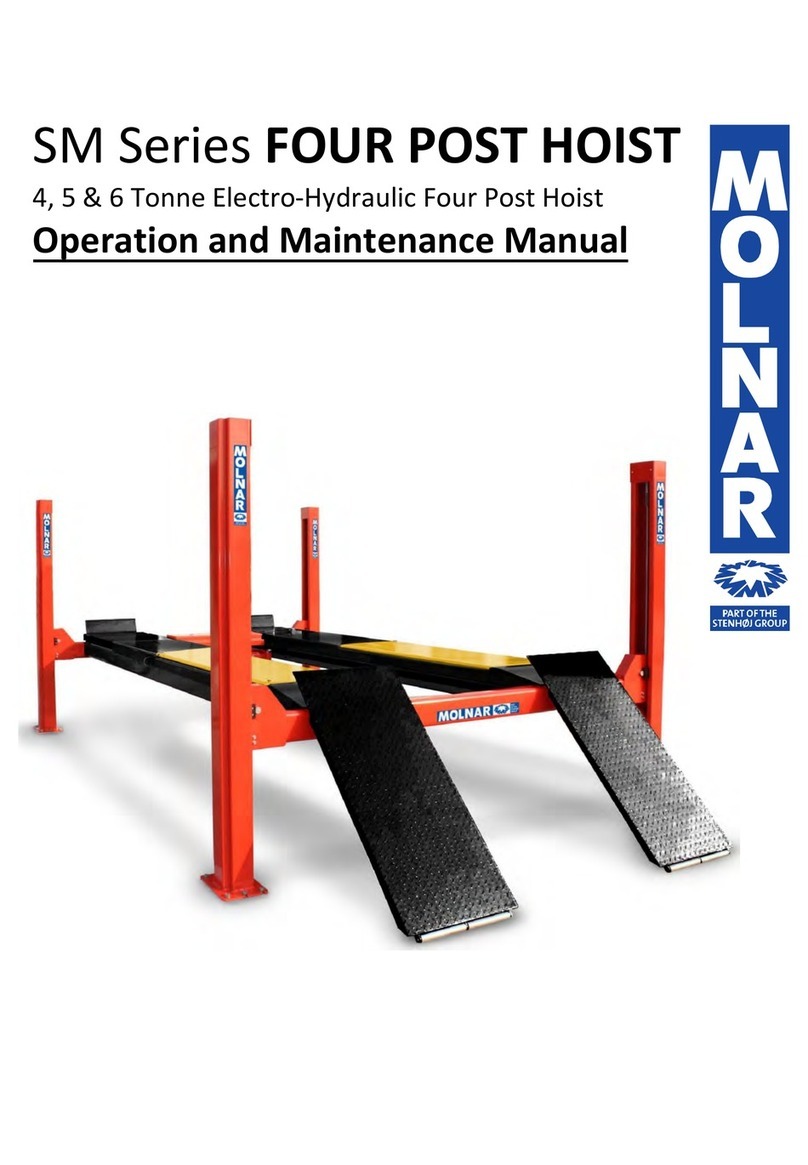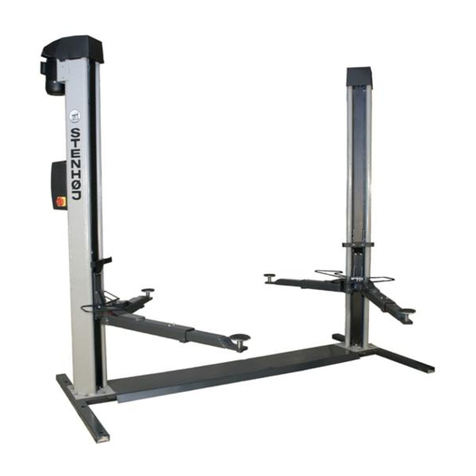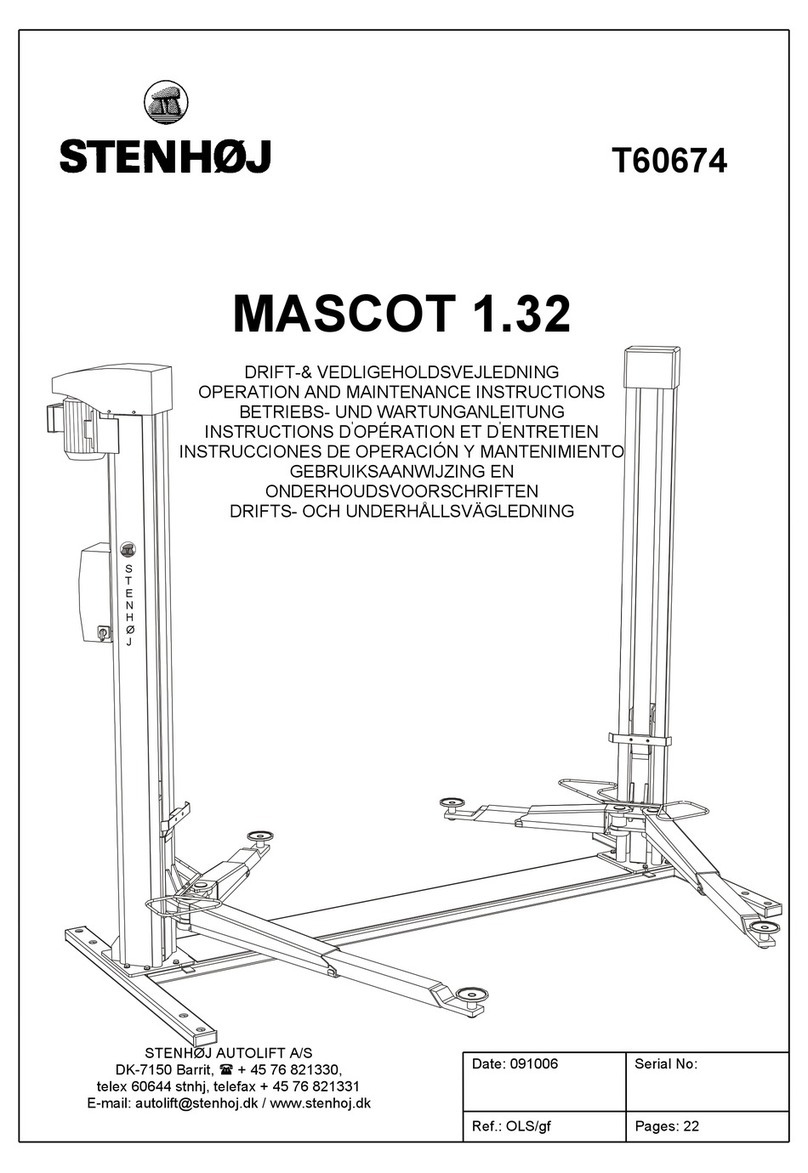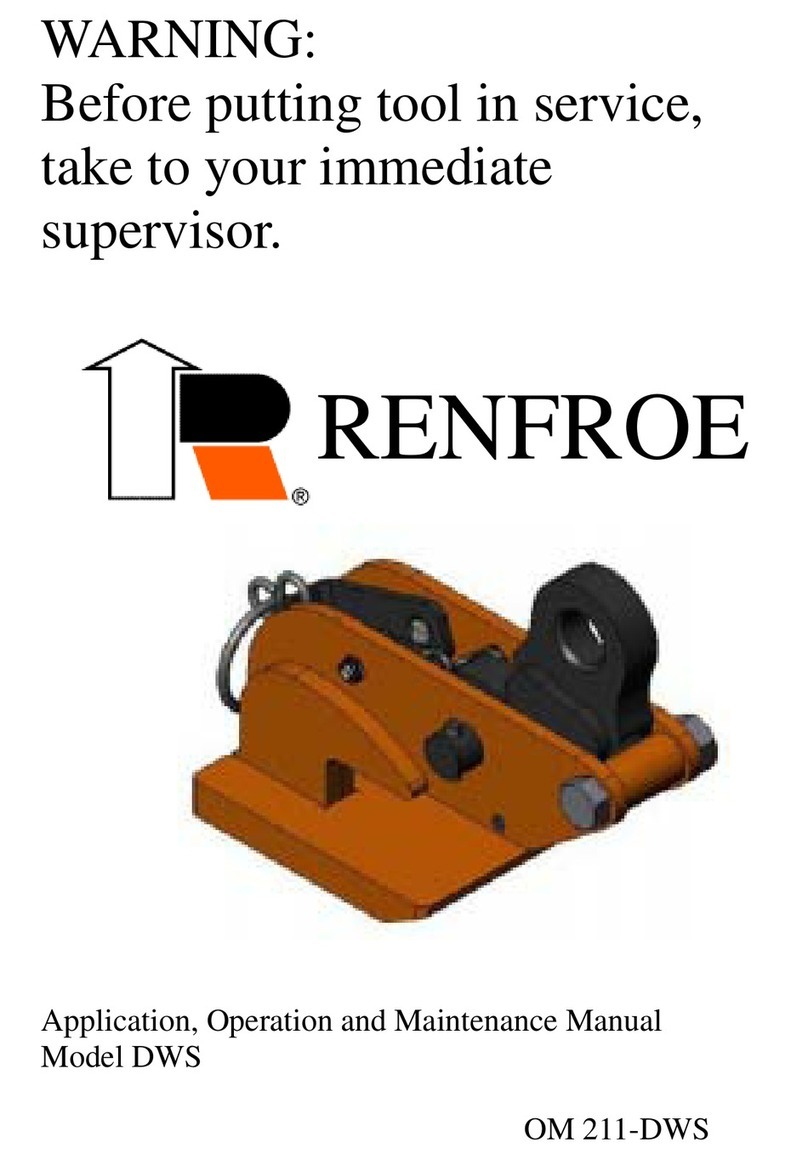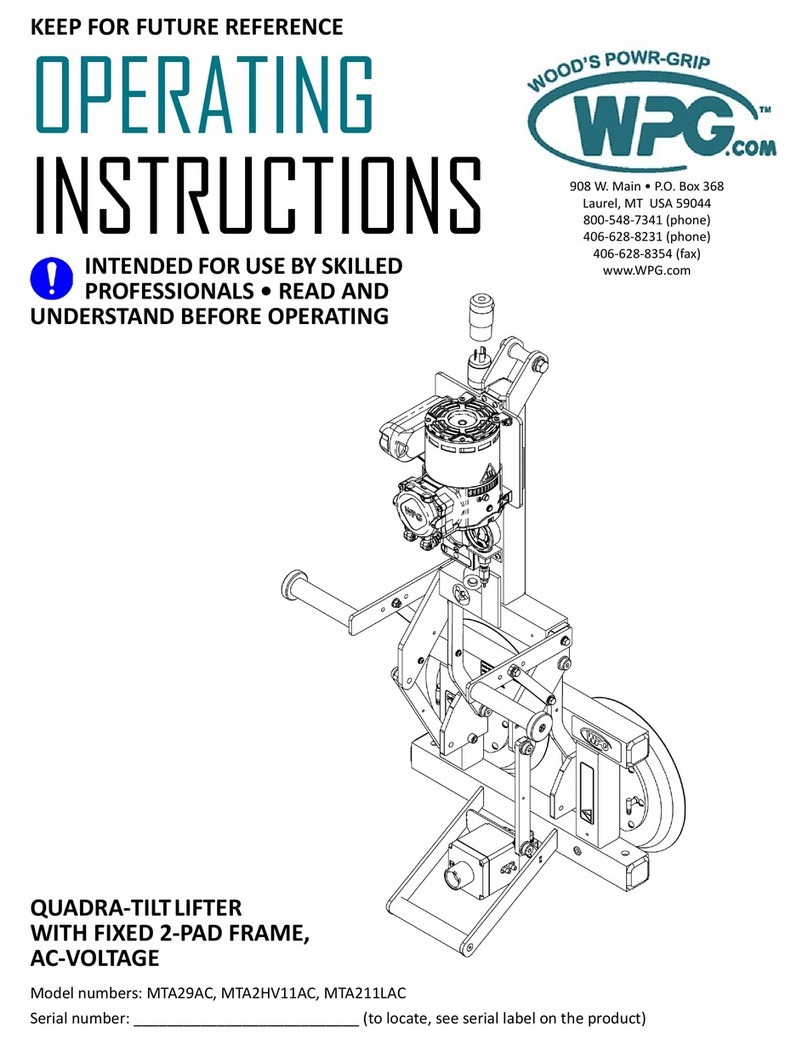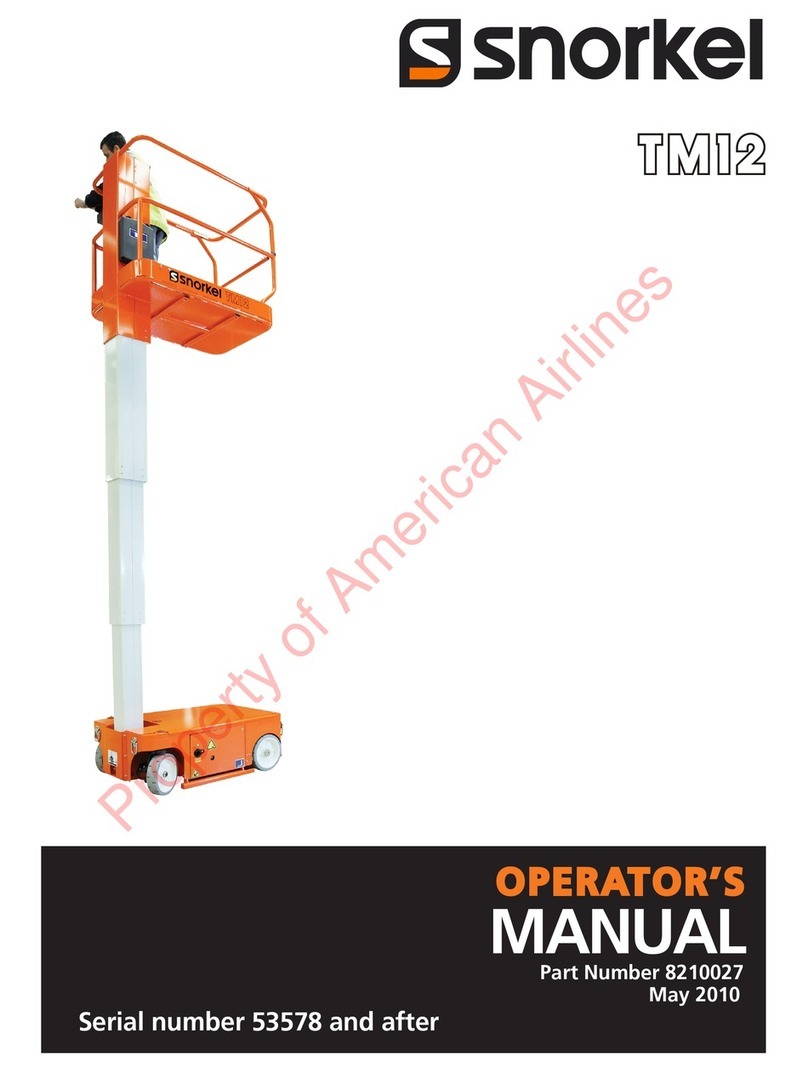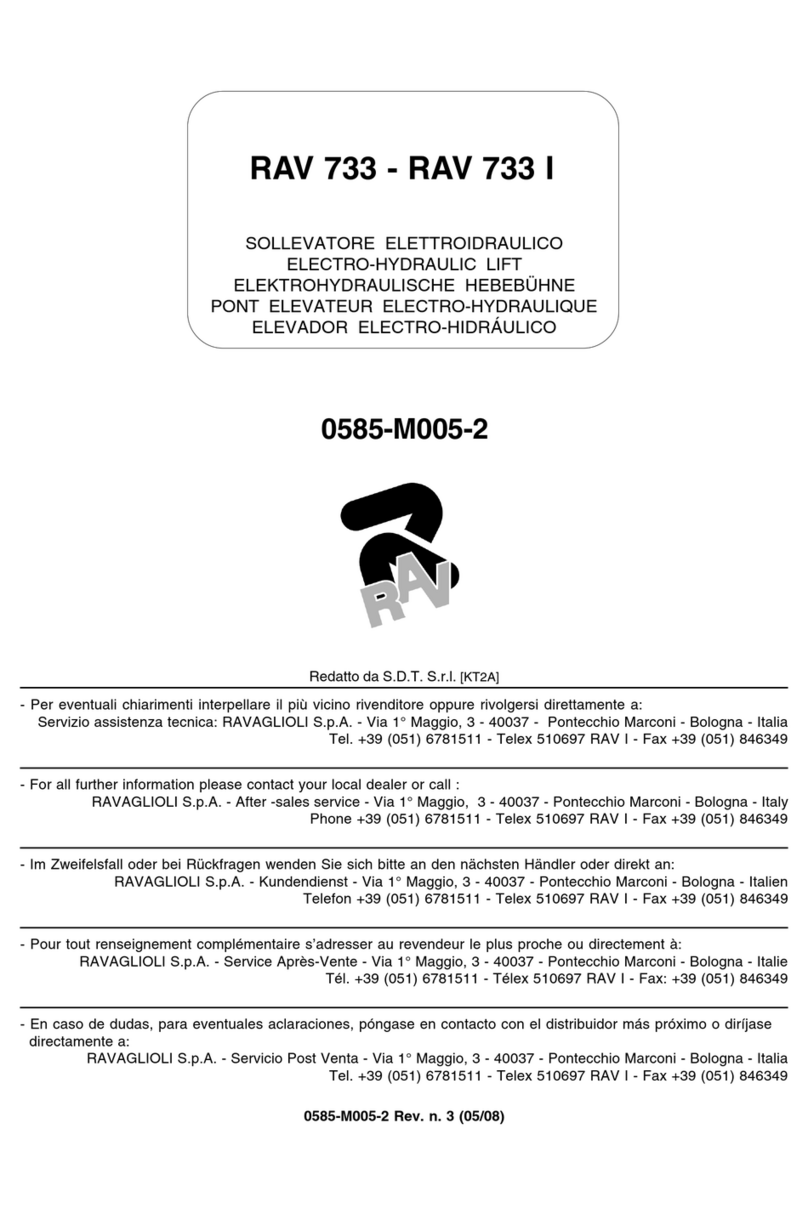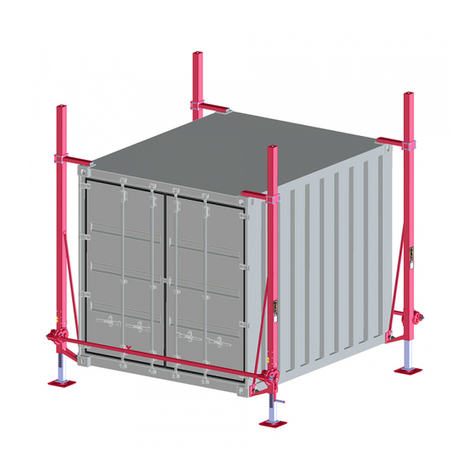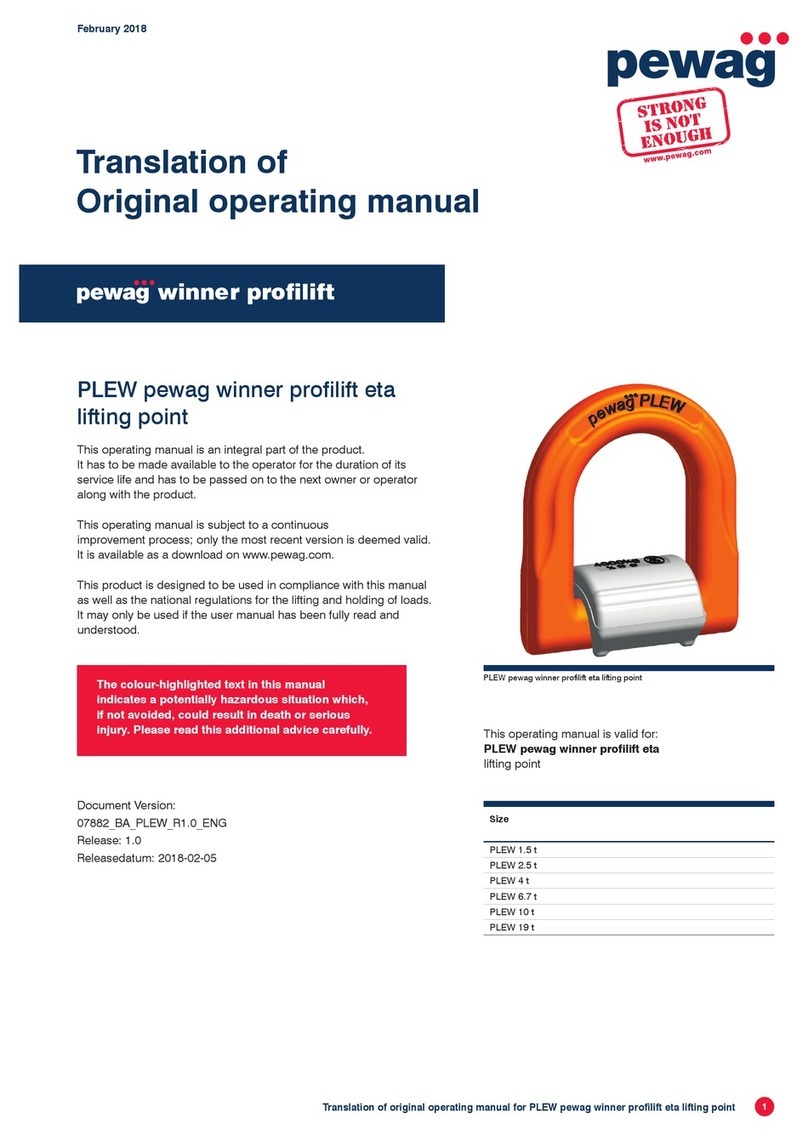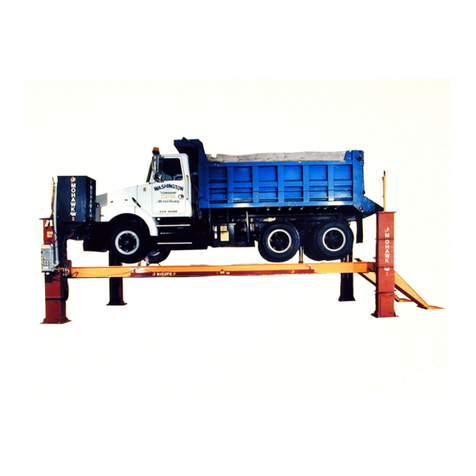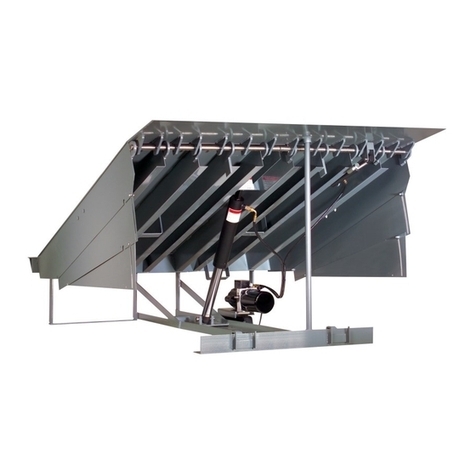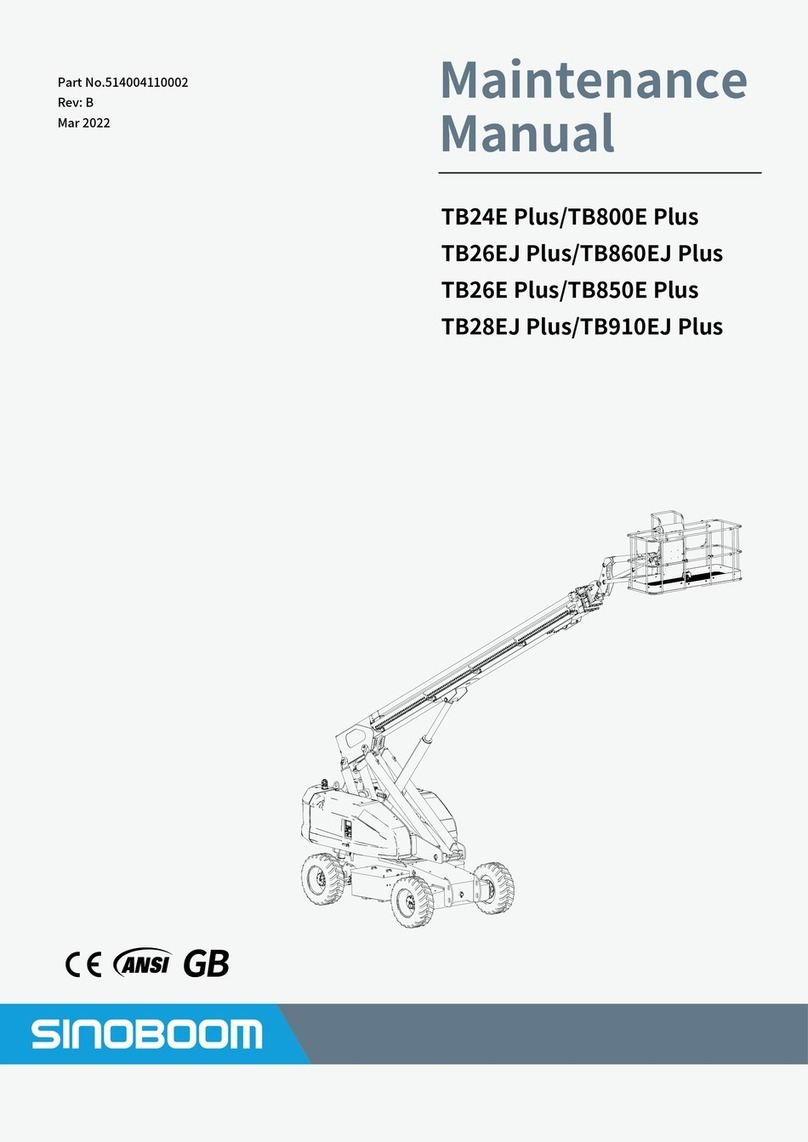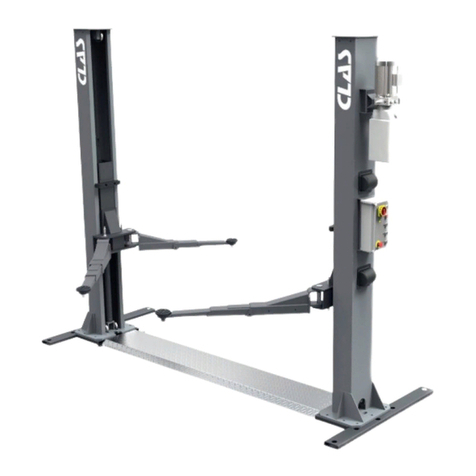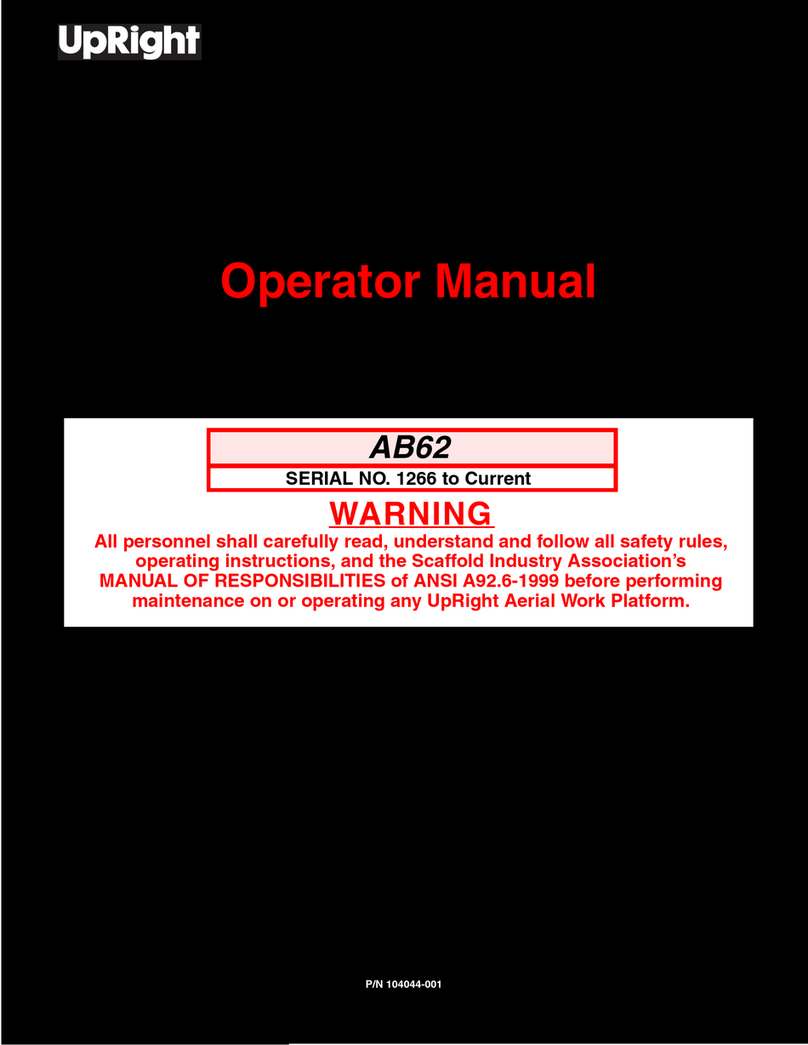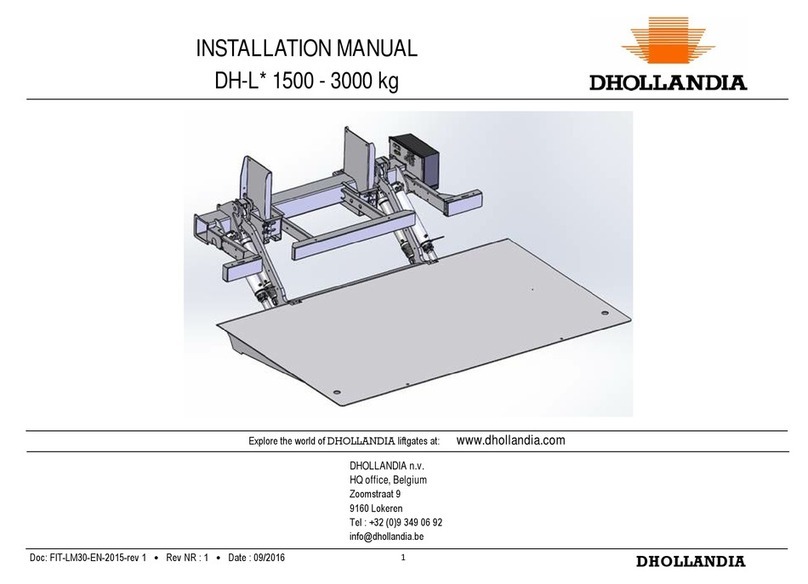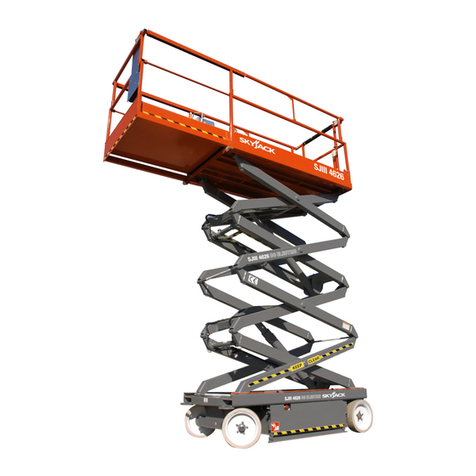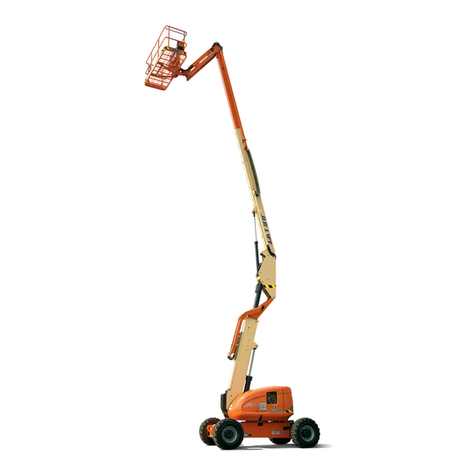Stenhoj MOLNAR BRADBURY SB40 Specification sheet

Please read this manual before you get started.
You must read and understand the precautions for safety purposes and any damages that may occur to your property.
Installation/Operation & Maintenance Manual
SB40: 2POSTHOIST
SB40
Updated 19/05/21

NOTE TO THE USER
Please read this instruction carefully for safety and proper use of the car
hoist, and retain it for future reference.
ANY PART OF THIS PRINT MUST NOT BE REPRODUCED IN ANY FORM WITHOUT
PERMISSION.
THIS PRINT IS SUBJECT TO CHANGE WITHOUT NOTICE.
This manual was prepared in December of 2018. The Specifications/images are subject to
change without prior notice, images and sketches are for illustration purposes only.
This Manual is for model: SB40
Design Registration V1803235
Vehicle Hoist - Model No. SB40
As for the assurance of safety in design and construction of car hoist, read this Manual first.
Please make sure that this Manual is delivered to end users for their implementation of safety.
Don’t use the car hoist in a potentially explosive atmosphere.

Introduction
Features and Characteristics
Part Descriptions
Description
Specification
4
4
6
7
7
Installation Procedures
Checklist Before Installing
Place of Installation-Layout
10
10
11
Safety
Danger/Warning/Caution
8
8
Operation
Check Points Before Operation
Operation
Operation Procedures of Each Part
16
16
17
28
Maintenance
Maintenance
Troubleshooting
Check List and Periodic Maintenance
Part List
20
20
23
24
IntroductionSafetyInstallation
Operation
Mainternance
Part List
TABLE OF CONTENTS

4
Features and Characteristics
Upper limit protection bar
Industrial direct
drive cylinder
Arm lock gear
Introduction
Door protection rubber
■ Upper limit protection bar
▶A limit bar prevents the vehicle from
being lifted too high.
This feature effectively protects
taller vehicles from being damaged.

5
■ Cable adjustment
▶Correct adjustment ensures
synchronization of both carriages.
Cable adjustment
■Operation of ram type cylinder
and longevity.
■ Powerful arm lock gear
▶At the bottom position the gears are
unlocked to allow arm adjustment. When
the hoist is raised the gears are
automatically locked ensuring
complete safety.
Unlocked Locked
Introduction
■ Door protection rubber
■ Safety locker
▶Vehicle door protect during working.
▶Safety locker system.
Two individual cylinders ensure reliability

6
Cross beam
Post extension
Slave post
Cylinder
Locker cover & Locker(inside)
Short arm
1
2
3
4
5
6
7
8
9
10
11
12
13
Drive post
Power Pack
Carriage
Door protection rubber pad
Long arm
Pick-up pad
1
2
3
4
5
6
7
12
8
9
10
11
Part Descriptions
Introduction
13
Top limit touch bar

7
MODEL
CAPACITY
MAX. PRESSURE
MAX.HEIGHT
MIN. HEIGHT
STROKE
LIFTING TIME
LOWERING TIME
POWER & MOTOR
NET WEIGHT
SB40
4,000 Kg
14 Mpa
1,895~1,940 mm
95~140 mm
1,800 mm
Approx. 45 ~ 60 sec
Approx . 35 ~ 50 sec.
3Ph, 2.2Kw, 2Poles, 415V, 50Hz
700 kg
Specification
Introduction
1Ph, 2.2Kw, 2Poles, 240V, 50Hz

8
Warning before using the equipment
Danger/Warning/Caution
Make sure you follow the instructions.
otherwise critical injuries can occur.
Make sure you follow the instructions,
otherwise critical injury or damage can
occur.
Make sure you follow the instructions
otherwise injury or damage can occur.
The terms are described to enhance
the understanding of the equipment.
Information to use the equipment
efficiently.
Precautions or check points for the
use of the equipment.
Please refer to the page
Rules for illustrations
in the manual
Do not come under
the vehicle during
operation.
▶ It may cause
severe injuries.
Evacuate to a safe
place instantly in the
event that the vehicle
tips.
▶ It may cause
severe injuries.
Do not overload the
rated capacity.
▶ It may cause
severe injuries.
※Fail to follow the
instructions can lead
to a critical accident
involving your life.
Make sure you follow
the instructions.
Only trained
personnel may
operate the
equipment.
Inexperience can
cause accidents.
Position the vehicle
to make sure that it is
balanced front and rear,
right and left (otherwise
the vehicle may fall off).
Do not operate damaged
equipment (a critical accident
could occur - contact your
supplier
After that a vehicle is
placed on the hoist
make sure that the
hand brake is applied.
Passenger transport
is forbidden.
Safety
These are the rules
for the illustrations
in the manual.
Make sure that you
read and
understand them.

9
Make sure you follow the instructions.
otherwise critical injuries can occur.
Make sure you follow the instructions
otherwise injury or damage can occur.
Warning before using the equipment
Warning when operating
Warning when operating
Warning when operating
Allow no unauthorized
persons in the work
area.
Before lowering the
hoist, check that there
are no obstructions
under the vehicle or the
hoist arms.
When the vehicle is
lifted, do not rock it as
this may dislodge it.
Do not raise a vehicle
using one pair of arms
only.
To avoid injury, keep
your feet clear of the
arms and carriages.
Before going under
the hoist, make sure
that the safety pawls
are engaged.
To avoid being
electrocuted,
disconnect the
main power before
opening the control
panel.
Do not modify the
control panel or the
safety functions as
this may impair their
function.
Do not rock the
vehicle when lifted.
Do not use a high
pressure cleaner as
the vehicle lower part.
Read and fully
understand the
manual before using
the hoist.
Check the safety
devices to see that
they are clean and
operable.
If the hoist is idle for a
long time, disconnect
the main power
supply. In the event
of thunder storm.
disconnect the main
power supply.
Safety

10
Installation site
Check List Before Installing
The site must be
flat and horizontal.
The floor must have
minimum 160mm
depth of reinforced
concrete.
Surface load under
the posts must be
minimum 25N/㎟
Ambient temperature
10℃ to 50℃. Do not
operate under
freezing conditions.
Installation site
Vehicle access to
the hoist must be
safe and easy.
There must be a safe
working distance of
minimum 1m between
the hoist and the wall or
any fixed object.
To ensure that the
anchor is secure, the
hole for an anchor
bolt must be more
than 2/3 of the bolt
length.
Installation site
To maintain the warranty, the hoist is intended for
indoor installation only. In the event that it is installed
outside it should be protected from snow and rain.
Outdoor installation makes the warranty invalid.
Only competent
technicians shall install
the hoist, otherwise a
failure may occur.
Installation
The hoist must be installed by competent technicians. Failure to observe this
makes the hoist warranty invalid. If the hoist is to be moved to another site at a
later date, it must be reinstalled by competent technicians.

11
45
2516
3440
R1075
R600
R920
R1400
1895
1940
95
140
Place of Installation-Layout
Check points before selecting the place of installation.
① Distance from wall or any fixed object
② Drive-on direction
③ Positions of power post and slave post
④ Ceiling height and height of cross member
Installation
3750
3560
2856

12
12
■Setting up a post
Anchor bolt installation
① Drill a hole
② Clean the inside of the hole
③ Put an anchor bolt into the hole and hammer
it until it reaches the bottom of the hole
④ Tighten the bolt with a spanner (ⓐ:35~45mm)
(Tighten more 80N.m~100N.m)
▶Before securing with anchor bolts, ensure
that the post is vertical in both directions.
Vertical balance
Check that the post is vertical in both
directions and adjust by means of the shim
plates provided.
Fix by anchor bolts.
Adjusting verticality
Fixing the post
1
2
■Connection of the hydraulic hose
▶Before setting up the post, connect the
hydraulic hose and tighten it with a 19/17mm
spanner. Check for oil leakage.
Installation

13
■Cable synchronization
▶The cables ensure synchronization
between the carriage on the power post and
the carriage on the slave post.
① Top roller for cable.
② Synchronization cable from the
opposite carriage.
③ Synchronization cable mounting
bracket.
④ Bottom roller for cable.
Check which carriage first touches the
base plate of the post when the hoist descends
and then tighten. This cable until both carriages
lest on lie base plates simultaneously.
Adjusting the cables
How to check the tuning
adjustment.
① Check with "naked eyes" that the bottom
post reached simultaneously see above.
② Check with ears
Check the sound of the parking pawls
engaging in each slat during ascent.
The "clicks" should be simultaneously
if not tighten the cable on the later pawl.
(The wire of the locker that sounds later
shall be tightened more tensely.)
Installation

14 14
Installation
■Hydraulic Diagram
LOWERING VALVE
9/16-18 UNF

15
Installation
■Electrical Diagram

16
Check Points Before Operation
■ Test Operation
Before loading the hoist check
the following points.
▶Operate the hoist up and down 2-3 times to
check the full travel of the carriages.
■ Switch Operation
▶Check that the ascent and descent lever
operate correctly.
■ Hydraulic Check
▶Check that there are no hydraulic leaks
from either cylinders, pipes, or hose joints.
■ Mechanical Check
▶Check the tightness of all nuts, bolts, etc.
■ Exterior Check
▶Check the exterior of the hoist to ensure
that there is no obvious damage.
■ Cleanliness
▶Check every day that the hoist and the
work area are clean and free from debris or
obstructions.
Operation

17
Operation
Check that the carriages and arms are at
lowest position by operating the lock
release lever and descend lever.
Prior to use
1
At the bottom position the arm locks
are released. Swing the arms to the
straightahead position as shown.
Prior to vehicle entry
2
Position the vehicle centrally between
posts with the vehicle's center of gravity in
line with the 2 posts.
Vehicle entry
3
Raise the hoist approx. 50mm and
check visually and mechanically to
ensure that each arm lock is firmly
engaged.
Check the arm locks
5
Swing in the 4 arms under the vehicle and adjust
the length of each arm so that the pick-up pad is
directly underneath the pick-point recommended
by the vehicle manufacturer. Each pad is fitted with
telescopic thread allowing a 2-stage adjustment.
Adjust the height of each pad to engage the pick-up
point.
Arm and pad adjustment
4
Operation

18
After checking that the 4 pads are correctly adjusted
under the pick-up points recommended by the
vehicle manufacturer and that the arm locks are
engaged as previously described, press the
ascent push button and raise the hoist to the
required working height.
Ascent
6
Before going under the hoist, check again visually
the pick-up pads and arm locks. After repair of the
vehicle, check the floor and work area to ensure that
there are no obstructions. Press the descent push
button to lower the hoist. When the hoist is at the
bottom position, the arm locks are released
automatically. Release the pick-up pads from the
pick-up points by screwing down the telescopic
threads. Swing the arms from under the vehicle to
the straight-ahead position and remove the vehicle.
Vehicle repairs
7
Operation Procedures of Each Part
■ Arm Lock Operation
When the carriages go up the arm locks
are engaged automatically. Ensure that the
gears controlling the locks are in mesh,
i.e. fully engaged. If not, the arm must be
marginally adjusted until the spring loading
operates and locks successfully.
Ascent
1
■ Arm Operation
the arms are telescopic with either 2
sections or 3 sections as shown to allow
the required adjustment.
Adjustment of arm length
1
At the bottom position the locks are
automatically disengaged.
Descent
2
2 section 3 section
Operation

19
ⓐ 55 mm
ⓑ 75 mm
ⓒ 100 mm
ⓓ Dia.120mm
▶ 26K Arm
2-section telescopic arm
ⓐ 920 mm
ⓑ 1400 mm
3-section telescopic arm
ⓐ 600 mm
ⓑ 850 mm
ⓒ 1075 mm
The height of the pad can be adjusted 3
stages as shown below.
3-stage telescopic pad adjustment
2
Operation

20
Maintenance
■ Lubrication
■ Cleanliness
▶At 2-or 3-month intervals, depending on
service usage.
▶Apply molybdenum disulphide grease liberally to
the carriage guides and the guide runners inside
the posts.
Molybdenum disulphide grease
1
▶Check every day that the hoist is clean and
that the work area is clean and free from
debris or obstructions.
▶Clean safety devices at 2-or-3-month intervals,
depending on service usage.
- Clean the arm lock gears and surroundings,
lubricate the gear teeth and the release
mechanisms. Clean the safety lock pawls, and
lubricate the axles.
■ Synchronization Cable Adjustment
▶Check that both carriages are fully parked on the
base of the hoist at the bottom position. Raise the
hoist without load and listen to the audible clicks of the 2
lock pawls. The synchronization of the
2 carriages is correct when both lock pawls click
simultaneously. Adjust the length of the 2 cables as
shown to fulfill this.
▶Lubricate with oil the upper and lower cable
rollers and axles.
Lubricating oil
2
Maintenance
Table of contents
Other Stenhoj Lifting System manuals

